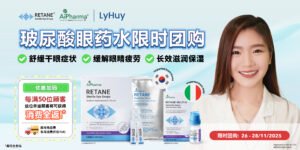This health article has been professionally reviewed by RPh Hiew Kai Ming, a registered pharmacist of Malaysian Pharmacists’ Society (MPS).
Dry eye is a common issue, particularly among office workers. Prolonged screen time, stress, and environmental factors can exacerbate dry eye symptoms, making it essential to select the right eye drops for relief. Here is a guide on what to consider when choosing eye drops.
Factors to Consider When Choosing Eye Drops for Dry Eyes
1. Preservative-free vs. Preservative Eye Drops
If you have moderate to severe dry eye and need to use eye drops more than four times a day, preservative-free eye drops may be a better option, as preservatives can cause irritation, especially with frequent use [1].
2. Single-Dose vs. Multi-Dose Eye Drops
Single-dose eye drops are ideal for minimizing contamination risk, especially if you use them frequently.
3. Viscosity
- Liquid Eye Drops: These are the least viscous, similar to water, and cause minimal visual blurring. However, they evaporate quickly, requiring frequent application.
- Gel Eye Drops: With higher viscosity than liquid drops, gel eye drops stay on the eye longer, providing sustained relief. However, they may cause temporary blurring.
- Ointments: The most viscous of all, ointments stay on the eye for extended periods, making them ideal for overnight use. However, their thickness can cause noticeable blurring.
4. Compatibility with contact lenses
If you wear contact lenses, ensure the eye drops you choose are compatible. Some eye drops are formulated specifically for contact lens wearers, providing moisture without causing cloudiness or residue.
Why Sodium Hyaluronate Is a Great Lubricant Eye Drop
Sodium Hyaluronate is a naturally occurring substance in the human body, known for its exceptional ability to retain moisture. Here’s why it stands out as an excellent choice for eye drops:
- Viscosity: Sodium hyaluronate has a high viscosity, which helps it coat the surface of the eye effectively and provide long-lasting lubrication. This is crucial for reducing dryness and discomfort [3].
- Hydration: It has a strong ability to attract and retain water. This hydration helps to keep the eye moist and alleviate symptoms of dryness or irritation.
- Viscoelastic Properties: Its viscoelastic nature allows it to mimic the natural properties of tears, providing a smooth and comfortable experience [4].
- Long-Lasting Relief: Sodium hyaluronate forms a stable and long-lasting protective layer on the ocular surface, which prolongs the duration of eye drop efficacy, reducing the frequency of application needed [5].
Conclusion: Selecting the right eye drops for dry eyes involves considering factors like preservative content, viscosity, and key ingredients. Sodium Hyaluronate offers superior hydration and protection, making it a top choice for relieving dry eye symptoms and supporting overall eye health.
References:
- Boyd, K. (2021). Lubricating Eye Drops for Dry Eyes. [online] American Academy of Ophthalmology. Available at: https://www.aao.org/eye-health/treatments/lubricating-eye-drops.
- American Academy of Ophthalmology. (2024). Choosing the Best Lubricant Eye Drops for Dry Eyes. [online] Available at: https://www.aao.org/eye-health/tips-prevention/how-to-choose-lubricant-drops-dry-eyes.
- Chernos, M., Grecov, D., Kwok, E., Bebe, S., Babsola, O. and Anastassiades, T. (2017). Rheological study of hyaluronic acid derivatives. Biomedical Engineering Letters, 7(1), pp.17–24. doi:https://doi.org/10.1007/s13534-017-0010-y.
- Nguyen, L., Lin, X., Verma, S., Puri, S., Hascall, V., Tarsis Ferreira Gesteira and Coulson-Thomas, V.J. (2023). Characterization of the Molecular Weight of Hyaluronan in Eye Products Using a Novel Method of Size Exclusion High-Pressure Liquid Chromatography. Translational vision science & technology, 12(4), pp.13–13. doi:https://doi.org/10.1167/tvst.12.4.13.
- Dogru, M., et al. (2013). “Effect of a New Formulation of High-Viscosity Hyaluronic Acid in Dry Eye Treatment.” Clinical Ophthalmology, 7, 1913-1919.






